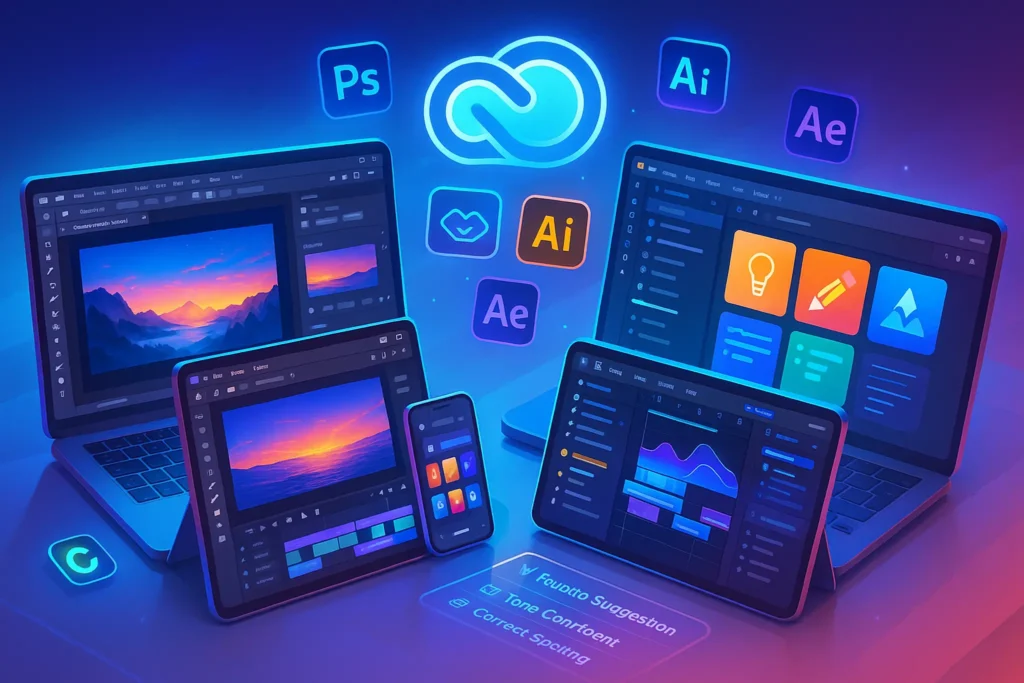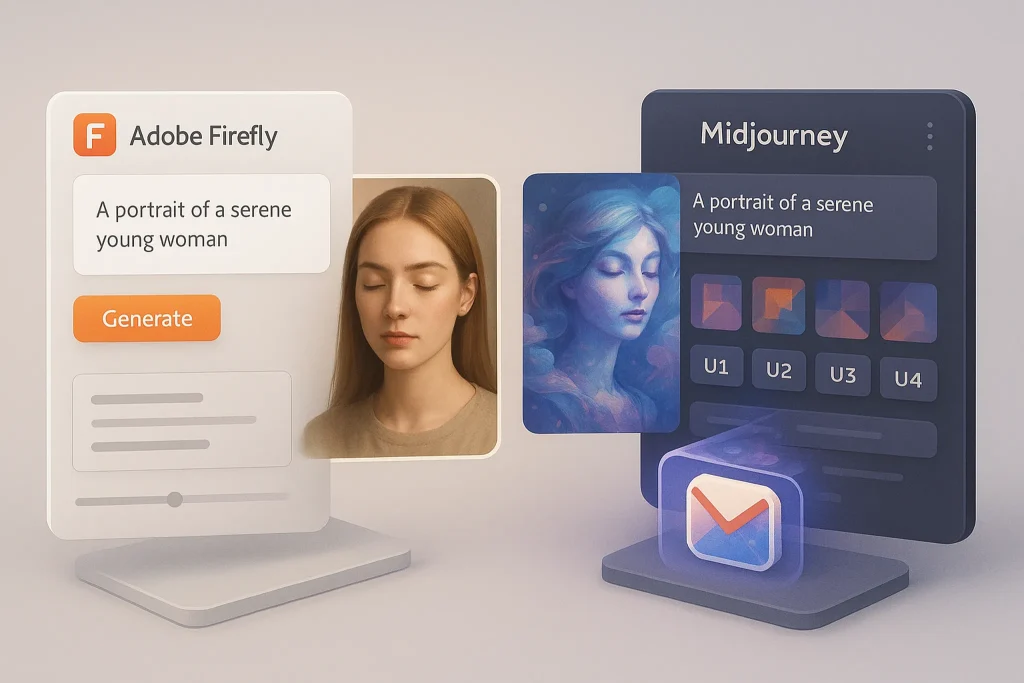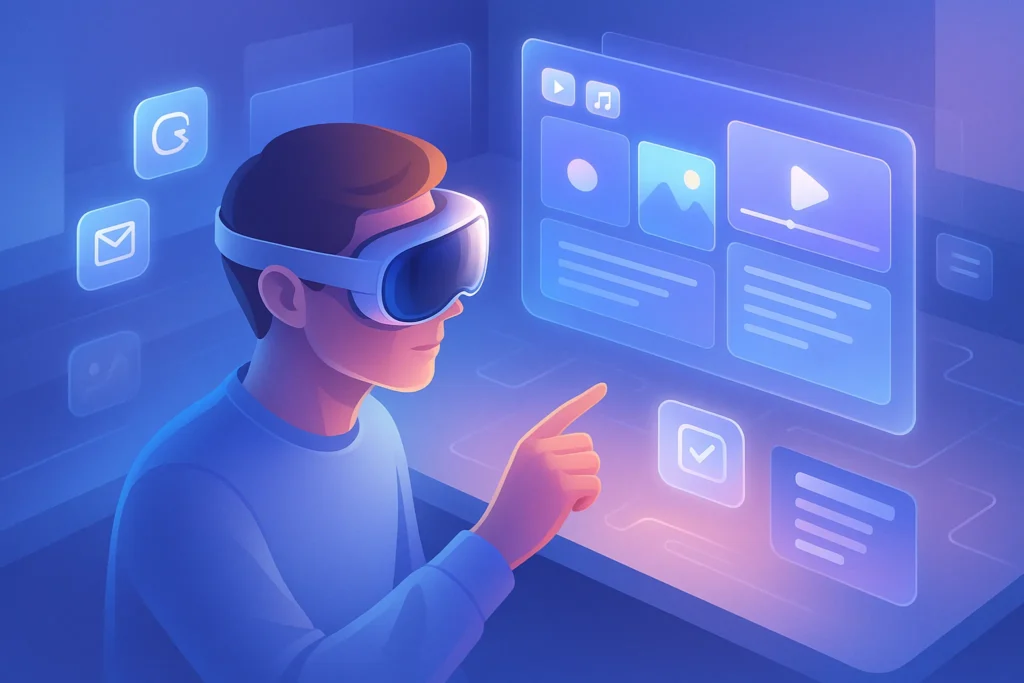-This post may contain affiliate links. If you click on one and make a purchase, I may earn a small commission at no extra cost to you.-
Intro: Adobe CC in 2025 — Creative Standard or Outdated Giant?
From Photoshop and Premiere Pro to After Effects and Illustrator, Adobe Creative Cloud has long been the go-to suite for creatives. But in 2025—with so many lightweight, AI-powered alternatives—is it still worth the price and complexity?
This is a hands-on, real-world review written from the perspective of those who live and breathe content creation:
-
🎨 Graphic designers
-
📹 Video editors
-
✍️ Content marketers
-
🧠 UX/UI specialists
We’ll break down the full suite, test the latest features (especially AI tools like Firefly), and compare Adobe CC to newer challengers like Canva, Affinity, and DaVinci Resolve. Whether you’re debating renewing your subscription or switching to something simpler, this review will help you make a smart decision.
🎨 What’s Inside Adobe Creative Cloud in 2025? (Use-Case Layering)
Adobe Creative Cloud currently includes 20+ desktop and mobile apps, but most creators regularly use a subset of tools based on their role.
Here’s how different professionals use the suite:
🧑🎨 Graphic Designers
Apps Used: Photoshop, Illustrator, InDesign, Lightroom
-
Create brand assets, posters, web banners
-
Work with vector & raster graphics
-
Use Adobe Fonts, Stock, and Libraries
🎬 Video Editors & Motion Designers
Apps Used: Premiere Pro, After Effects, Audition, Media Encoder
-
Edit YouTube videos, marketing reels, short films
-
Sync motion graphics across multiple apps
-
Clean up audio, apply LUTs, and export with precision
🧑💻 UX/UI Designers
Apps Used: Adobe XD, Illustrator, Photoshop
-
Build interactive prototypes and UI mockups
-
Integrate designs into web workflows (limited Figma integration)
-
Still relevant but increasingly under pressure from tools like Figma
📲 Content Creators / Marketers
Apps Used: Express, Photoshop, Premiere, Acrobat
-
Repurpose content for social platforms
-
Design carousels, infographics, ebooks
-
Leverage templates from Adobe Stock + Firefly
Whether you’re building a pitch deck or animating a logo, Adobe CC still covers the full creative spectrum—but does it feel modern in 2025?
💡 AI-Powered Features in Adobe CC: Do They Actually Save Time?
Adobe hasn’t just added AI—they’ve gone all-in.
With the rise of tools like Firefly and Sensei-powered automations, Adobe Creative Cloud in 2025 is more AI-centric than ever. But do these tools really boost productivity, or just look good in demos?
We tested the most talked-about features:
🖼️ Photoshop: Generative Fill with Adobe Firefly
Select an empty space. Type: “add a forest background in golden hour lighting”. Boom—done in 5 seconds.
Firefly’s Generative Fill now supports:
-
Inpainting with contextual lighting
-
Texture generation
-
Multi-object compositing
In a social media banner project, this saved ~20 minutes of manual masking and blending.
Curious how Firefly compares to tools like Midjourney? Check out our Adobe Firefly Review for a side-by-side breakdown.
🎥 Premiere Pro: AI Audio Cleanup + Auto Reframe
New AI-powered audio tools detect background hum and speech inconsistency—then clean it up with a single click.
Great for podcasts, interviews, or quick-and-dirty YouTube edits.
Pair this with Auto Reframe, and you can repurpose horizontal videos into vertical Shorts or TikToks instantly.
🧠 Real Use Case: A 4-minute client promo was resized to 3 aspect ratios and cleaned up—all in ~10 minutes. No need for external tools.
✍️ After Effects: AI Motion Sync + Auto Captions
Creating subtitles is no longer tedious. With Auto-Caption, After Effects now transcribes and times speech across layers.
Add to that AI Motion Sync, and you can animate lower-thirds or callouts automatically to match voice pace.
This feels especially useful for motion designers who used to rely on plugins like Motion Bro or paid captioning tools.
🧠 Micro-UX Prompt: Did the AI features actually save us time?
✅ Yes, especially for content creators working under pressure.
While professionals may still prefer manual control, the AI tools automate repetitive tasks without killing creativity.
⚠️ Caveat: You still need to review and refine—the AI isn’t flawless, especially when interpreting abstract prompts or fast speech.
TL;DR: Adobe’s AI is not a gimmick. For most mid-level to pro creators, it offers a real efficiency boost—not just shiny toys.
🧩 User Experience & Performance: Power or Clutter?
Adobe’s tools are famously powerful—but are they still intuitive in 2025?
Let’s break it down:
🖥️ Interface Design: Evolved or Outdated?
The UI across most Adobe apps—Photoshop, Premiere, Illustrator—retains its familiar layout. If you’ve used them before, you’ll feel at home. But newcomers may find the interface overwhelming, especially compared to modern minimalist tools like Canva or CapCut.
That said, Adobe has added:
-
Contextual AI sidebars (in Photoshop & Illustrator)
-
Workspace customization presets
-
Simplified export panels in Premiere & After Effects
🧠 Verdict: Still dense, but more navigable—especially with AI-assisted panels that guide you through complex features.
⚙️ Performance on Mac vs Windows
We tested the suite on two machines:
-
MacBook Pro M2 Max, 32GB RAM
-
Windows 11 PC, i9 CPU, 64GB RAM, RTX 3080 Ti
Both handled Adobe CC well—but Premiere Pro and After Effects felt slightly more optimized on macOS, especially during video scrubbing and real-time playback.
Photoshop and Illustrator performed similarly across both systems, though GPU acceleration on Windows allowed for smoother large canvas rendering.
For users debating between systems, check out our AI Video Editing Tools post, where we dive deeper into cross-platform creative performance.
🔋 Resource Usage & Load Times
Adobe apps remain heavyweight—even with improved efficiency:
-
Cold launches average 8–15 seconds per app
-
Background sync (Adobe Fonts, Libraries, Stock) consumes RAM
-
Real-time rendering requires a dedicated GPU for best results
🧠 Tip: If you’re using an older laptop, stick to Express, Photoshop (web), or Lightroom Mobile for lighter workflows.
✅ Bottom Line: Adobe’s user experience is gradually improving with AI guidance and smarter panels—but it’s still best suited for professionals who are willing to learn the tools. For casual users, it may feel excessive compared to simpler alternatives.
🔗 Integrations & Workflow Flexibility: Does Adobe Play Nice with Others?
In creative workflows, it’s not just about the tools—but how well they talk to each other.
Adobe Creative Cloud in 2025 has made serious progress in cross-app integration and external tool compatibility.
🔁 Adobe-to-Adobe Sync
-
Seamless asset sharing between Photoshop ↔ Illustrator ↔ InDesign
-
Premiere ↔ After Effects dynamic linking (no need to re-render)
-
Creative Cloud Libraries for team-wide asset access
-
Cloud docs now autosave versions and support real-time comments
🧠 Great for teams managing brand assets or publishing pipelines.
🌐 External Integrations
Adobe CC now connects with:
-
Frame.io (video collaboration)
-
Slack (comment notifications + file sharing)
-
Dropbox + Google Drive (import/export directly)
-
Notion & Trello (via Zapier or third-party plugins)
If you’re running a remote creative team, these integrations streamline feedback loops and version control—especially when syncing across design and video departments.
💰 Pricing & Subscription Dilemma: Power Has a Price
Adobe’s pricing has long been a hot topic. In 2025, it remains a subscription-only model, which continues to divide creatives.
🔸 Adobe CC Pricing (as of mid-2025)
-
Single App Plans: $22.99/mo per app (Photoshop, Premiere, etc.)
-
All Apps (Full Suite): $59.99/mo
-
Students & Teachers: ~$19.99/mo for the full suite
-
Teams & Business: $89.99/user/mo with admin tools
It adds up quickly—especially for solo creators who may only use 2–3 apps. While Adobe occasionally runs regional or bundle discounts, you’re locked into the ecosystem once you commit.
For budget-conscious creators, lightweight tools like Affinity, Canva Pro, or DaVinci Resolve Free offer strong alternatives at a fraction of the cost—or none.
🎯 Real-World Workflows: How Creators Actually Use Adobe CC
Sometimes the best way to evaluate a tool is to see it in action within real creator workflows. Let’s look at two common use-case scenarios:
🎬 YouTuber Workflow – Video Production with Adobe CC
Creator Type: Solo content creator with a weekly upload schedule
Tools Used: Premiere Pro, After Effects, Audition, Media Encoder
-
Script edits in Premiere (with auto-captions + timeline sync)
-
Add animated titles from After Effects using Dynamic Link
-
Clean up audio in Audition (AI noise remover + EQ match)
-
Render in multiple formats using Media Encoder presets
-
Thumbnail creation in Photoshop with smart layers & templates
🧠 Time Saved: ~3–5 hours per week compared to CapCut or Final Cut, thanks to integrated pipeline and AI assist.
This is where Adobe really shines—deep tools + interconnected ecosystem = full creative control.
🎨 Brand Designer Workflow – Creating Visual Identity
Creator Type: Freelancer working with startups and online brands
Tools Used: Illustrator, Photoshop, InDesign, Firefly
-
Logo concepting in Illustrator (vector workspace + grid guides)
-
Mockups in Photoshop with brand visuals over product images
-
Typography & color palette export using Adobe Fonts & Swatches
-
Business card & brochure layout in InDesign
-
Social templates created with Firefly’s background/scene generation
🧠 Client delivery: Brand guideline PDF, editable social templates, high-res print-ready files.
These real workflows illustrate how Adobe’s full suite enables end-to-end creation without switching platforms or re-exporting constantly.
If you’re a hybrid creator (designer + editor + social marketer), this all-in-one approach is unmatched—though it comes at a subscription price.
🧠 Adobe AI vs Competitor AI: Output Comparison Test
One of the most hyped parts of Adobe CC 2025 is its AI capability—especially Firefly, its image generation tool.
We ran a head-to-head test to see how it stacks up against similar tools:
🔍 Prompt:
“Generate a futuristic workspace scene with a laptop, headphones, ambient lights, and a city view in the background”
| Tool | Output Quality | Style Control | Editing Flexibility | Export Options |
|---|---|---|---|---|
| Adobe Firefly | Sharp, photorealistic | ✅ Layer masks | ✅ Smart Object layers | ✅ PSD, PNG |
| Canva AI | Stylized, but lower detail | ⚠️ Limited | ⚠️ Non-editable | ✅ PNG, JPG |
| Midjourney (V6) | Visually striking, very artistic | ✅ Advanced | ❌ Raster only | ✅ PNG |
Firefly gave us the most editable, brand-consistent output that could be further refined in Photoshop. Midjourney was more artistic, but not suitable for design pipelines. Canva was fast, but basic.
🎯 Bottom Line:
If you need AI images you can actually use in professional projects—Firefly wins. It’s not just about “wow”—it’s about workflow fit.
📊 Adobe vs Competitors (Canva, Affinity, DaVinci)
| Feature/Tool | Adobe CC | Canva Pro | Affinity Suite | DaVinci Resolve |
|---|---|---|---|---|
| Photo Editing | ✅ Photoshop | ⚠️ Basic editor | ✅ Affinity Photo | ❌ |
| Graphic Design | ✅ Illustrator | ✅ Templates | ✅ Affinity Designer | ❌ |
| Video Editing | ✅ Premiere Pro | ❌ | ❌ | ✅ (Pro-level) |
| AI Tools | ✅ Firefly, Auto-sync | ✅ Magic Resize, BG Remover | ⚠️ Limited AI | ✅ Color grading AI |
| Pricing | 💰 $60/mo | 💵 $12.99/mo | 💵 One-time ($169 total) | 💵 Free (basic) |
| Offline Access | ✅ Full | ⚠️ Cloud-heavy | ✅ Full | ✅ Full |
| Learning Curve | ⚠️ High | ✅ Very Low | ⚠️ Medium | ⚠️ High |
Adobe still offers the broadest and most advanced toolkit, but it’s expensive and overkill for simpler tasks. If you’re just creating marketing graphics or editing YouTube Shorts, Canva or CapCut might be all you need.
🧠 Nerd Verdict: Still the King of Creative—But Not for Everyone
After weeks of testing Adobe Creative Cloud in real creative projects, here’s the honest bottom line:
👍 Who It’s Perfect For:
-
Creative professionals who need maximum control over their work
-
Teams who collaborate across different formats (photo, video, design)
-
Content creators who value powerful features over ease-of-use
-
Agencies who manage brand consistency across platforms
👎 Who Might Look Elsewhere:
-
Casual creators making social content with Canva or CapCut
-
Freelancers who only use 1–2 tools and want to avoid subscriptions
-
Students on a tight budget (despite Adobe’s student plan)
Adobe CC is still the gold standard—but only if you actually need gold. For everyone else, lighter (and cheaper) tools are catching up fast.
❓ FAQ: Nerds Ask, We Answer
💬 Would You Bite?
Are you still using Adobe Creative Cloud in 2025—or have you moved on to lighter tools like Canva, DaVinci, or Affinity?
If you could only subscribe to one tool… which would it be?
👇 Comment below and let us know your go-to creative weapon.



